

We Are Museums 2014 (Warsaw, Poland) How A Museum Can Regenerate An Entire City. Like many medium-sized cities around the world, Villahermosa, Mexico, could benefit from a shiny new museum to draw tourists and provide public space for its residents.
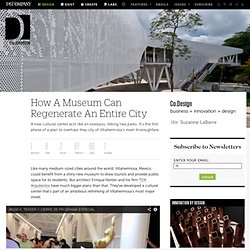
But architect Enrique Norten and his firm TEN Arquitectos have much bigger plans than that. They've developed a cultural center that's part of an ambitious rethinking of Villahermosa's most major street. The Museo Elevado de Villahermosa, or Musevi for short, is a new cultural center in Villahermosa that's part of Norten's fresh master plan. The structure sits on (and over) the busy Paseo Tabasco, which will undergo a larger transformation to make the street a green, mixed-use, multi-modal thoroughfare for bikes and pedestrians.
The site is unique in that it links two parks, each with their own lakes, which had previously been divided by the busy street. United Nations Alliance of Civilizations. PLURAL+ 2014 Call for Entries is open!
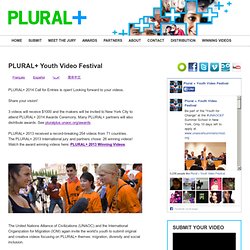
Looking forward to your videos. Share your vision! 3 videos will receive $1000 and the makers will be invited to New York City to attend PLURAL+ 2014 Awards Ceremony. Many PLURAL+ partners will also distribute awards. See pluralplus.unaoc.org/awards PLURAL+ 2013 received a record-breaking 254 videos from 71 countries. The United Nations Alliance of Civilizations (UNAOC) and the International Organization for Migration (IOM) again invite the world’s youth to submit original and creative videos focusing on PLURAL+ themes: migration, diversity and social inclusion.
Recognizing youth as powerful agents of social change in a world often characterized by intolerance, and cultural and religious divisions, PLURAL+ invites youth to address key challenges related to migrant integration, inclusiveness, identity, diversity, human rights and social cohesiveness, both at local and global levels. Your Online Museum Design Community. The Museum of the Future » What to do if ‘they’ are not online? – 7 actions to promote new media in your museum. Photo by Ally Oop on Flickr.com “My organisation does not see the importance of social media.”
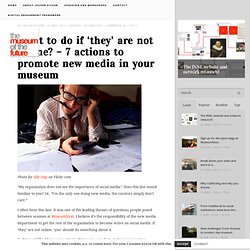
Does this line sound familiar to you? Or, “I’m the only one doing new media, the curators simply don’t care.” I often hear this line. It was one of the leading themes of questions people posed between sessions at MuseumNext. In this post I’ll address some simple things you can do to make your curators, marketing team, mother and small pets go online. Empowering Staff to Take Creative Risks. What kind of support do you need to be confident about taking a risk in your work?
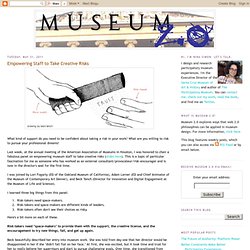
What are you willing to risk to pursue your professional dreams? Last week, at the annual meeting of the American Association of Museums in Houston, I was honored to chair a fabulous panel on empowering museum staff to take creative risks (slides here). This is a topic of particular fascination for me as someone who has worked as an external consultant/provocateur/risk-encourager and is now in the director's seat for the first time. I was joined by Lori Fogarty (ED of the Oakland Museum of California), Adam Lerner (ED and Chief Animator of the Museum of Contemporary Art Denver), and Beck Tench (Director for Innovation and Digital Engagement at the Museum of Life and Science). 2010 Horizon Report: Museum Edition Released. Tate Papers Issue 13 2010: Tate Online Strategy 2010-12, John Stack. Research: Social Media Audiences and the Museum. The following research was conducted on behalf of MuseumNext and Sumo in April 2011 by an independent market research company with a sample of 500 UK residents.

This survey aims to provide some context for museums looking to use social media. Les musées en partage Avec Google Art Project, lancé cet hiver, on peut avoir accès, dans le confort de son foyer, à des reproductions de grandes oeuvres d’art de musées célèbres avec un niveau de détails incroyables (jusqu’à 7 milliards de pixels).
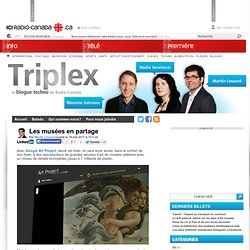
Mais les musées ne se limitent pas à montrer simplement des oeuvres, car, selon la définition de l’ICOM, un musée est aussi « une institution au service de la société et de son développement ». Voilà pourquoi il y a, aujourd’hui, comme chaque année depuis 1977, la Journée internationale des musées. Les musées cherchent constamment à redéfinir leur rôle pour rester au service de cette mission.
Ils le font pour conserver leur autorité auprès des pairs et des donateurs, et aux yeux du public. Les musées se sont transformés au même titre que la société. La relation avec le public reste pour eux un souci omniprésent. Une question de voix La promotion via les médias sociaux est une chose, mais savoir tenir une conversation avec le public en est une autre.
Traces. Notes from Museums and Technology Talk « A Great Becoming… Recently Danny and Martha from Wellcome gave a talk about the interesting stuff they’d seen at the Museums and the Web event in Philadelphia.
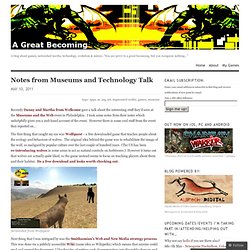
I took some notes from their notes which unhelpfully gives you a 2nd-hand account of the event. However there is some cool stuff from the event they reported on… The first thing that caught my eye was Wolfquest – a free downloaded game that teaches people about the ecology and behaviour of wolves. The original idea behind the game was to rehabilitate the image of the wolf, so maligned by popular culture over the last couple of hundred years. (The US has been re-introducing wolves in some areas to act as natural controls on herbivores.) Screenshot from Wolfquest Next thing that I was intrigued by was the Smithsonian’s Web and New Media strategy process.
There were also some interesting apps mentioned during the talk.